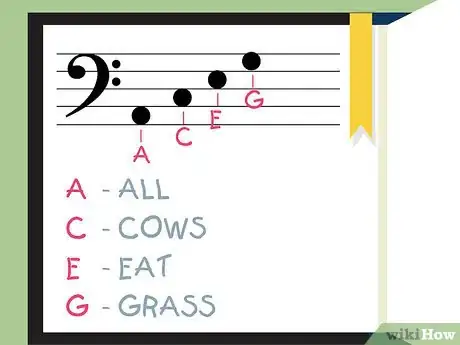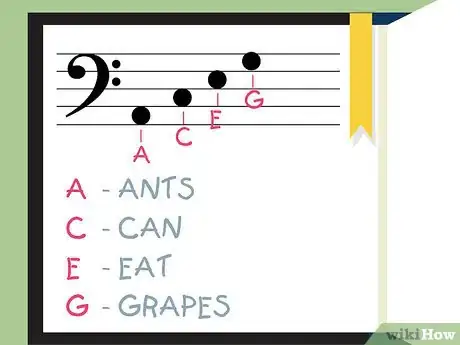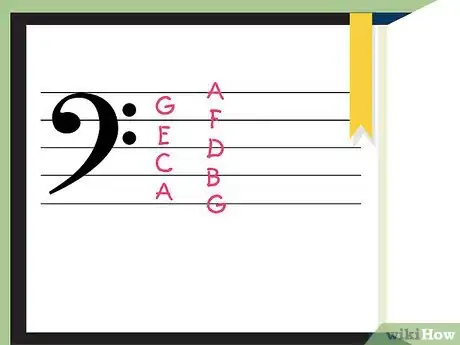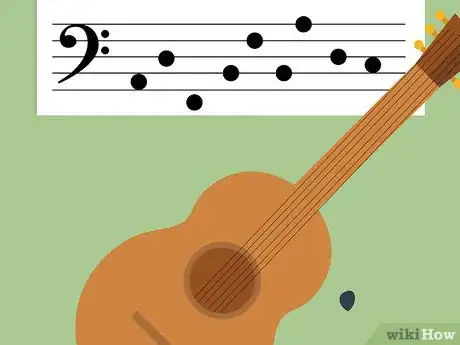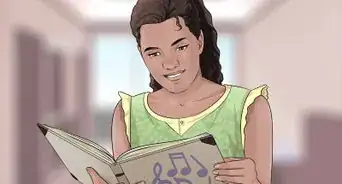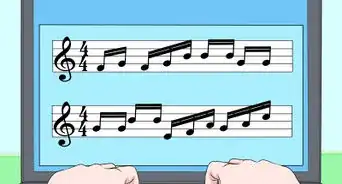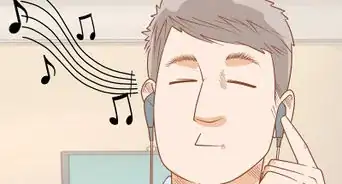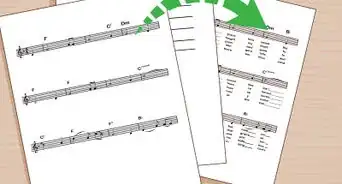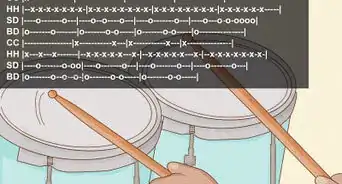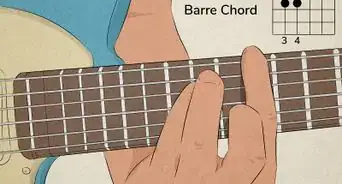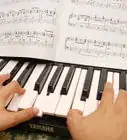This article was co-authored by wikiHow Staff. Our trained team of editors and researchers validate articles for accuracy and comprehensiveness. wikiHow's Content Management Team carefully monitors the work from our editorial staff to ensure that each article is backed by trusted research and meets our high quality standards.
wikiHow marks an article as reader-approved once it receives enough positive feedback. This article received 12 testimonials and 83% of readers who voted found it helpful, earning it our reader-approved status.
This article has been viewed 283,517 times.
Learn more...
If you are learning the bassoon, the cello, or other low-pitched instrument, learning to read the bass clef is one of the first challenges you will face. Fortunately, by using some simple music theory concepts, mnemonic phrases and a bit of practice, you can read bass clef with ease.
Steps
Understanding the Staff
-
1Learn the basic parts of the bass clef.
- Staff: This is the collection of five lines and four spaces that music is written on. Notes can go above and below the staff as well. Each line and space matches a specific note.
- Ledger Lines: Lines above or below the staff that are added to expand the staff. Remember, however, that they all must have spaces between them as well, which indicate notes.
- Bass Clef: This is the backward "C" on the left-hand side of the staff. The two dots behind the "backward C" circles the second highest line of the staff, and that note should be F (the closest F below middle C on the piano)
-
2Remember "All Cows Eat Grass" to memorize the notes in the spaces from the bottom up. The lowest space (the one between the bottom line and the second lowest line) represents an A. The space above it represents a C, then an E, then a G. Thus, the notes in the spaces, form the bottom up, can be remembered:
- -------
- Grass
- -------
- Eat
- -------
- Cows
- -------
- All
- -------
Advertisement -
3Remember "Grizzly Bears Don't Fly Airplanes" to memorize the notes on each line from the bottom up. The very lowest line is a G, then a B, then a D, F, and finally A. You can make up any mnemonic you'd like, but the classic is always easy to keep in mind:
- ---Airplanes---
- _________
- ---Fly----
- _________
- ---Don't----
- _________
- ---Bears----
- _________
- ---Grizzly----[1]
-
4Try out a few different mnemonics if you don't like the ones provided. Don't worry if you hate thinking about bears or cows. There are a variety of other mnemonics available, and you could even invent your own if you wanted. Remember that all of these count from the bottom up, because the notes go from lowest to highest.
-
Spaces:
- Ants Can Eat Grapes
- American Composers Envy Gershwin
-
Lines:
- Great Beagles Dig For Artwork
- Good Bikes Don't Fall Apart
- Garbage Bags Do Fly Away.[2]
-
Spaces:
-
5Count through the alphabet, starting with G on the bottom line, to figure out the notes above and below the staff. The bass clef simply moves through the alphabet, with each line and space representing one "move." So, since the bottom line is a G, the space above it is an A. The line above that space is a B. The next space is a C, and so on, until you get back to another A on the top line. This will also help you with the lines above and below the staff. Simply work through the alphabet, counting each space and line equally:
- Your middle C is on the first ledger line above the staff. The space beneath it is a B.
- The space right below the staff is an F, and the first ledger line beneath it is an E.
Improving your Reading Speed
-
1Test yourself with "music reading quizzes," which require you to pick the note as quickly as possible. The best way to get good is to practice, and the best practice is reading notes as quickly as you can. There are many online quizzes for free, but you can also print out a collection of notes on a bass clef (or have a friend or teacher write one) and practice identifying each one perfectly.[3]
- As you get better, time yourself on each quiz. Work on improving your accuracy along with your speed -- don't sacrifice quality for speed until you can get each note without mistakes.
-
2Hit the matching note on your instrument as you read each note. Print out or write down a staff with a random collection of notes. As you identify each one, play the same note on your instrument. This will train your brain to not only identify the note but the sound and the physical positioning of each part of the staff. You'll improve your playing speed considerably as a result.
-
3Practice with written music each time you practice. If you want to work on reading music, in any clef, read music and play. Even if you mostly improvise, work on scales, or don't use written music, you should still devote 10-20 minutes to reading music and playing along.
-
4Try sight-reading to warm-up and work on your bass clef skills. Sight reading is when you put a brand new piece of sheet music in front of you and play it as you read for the first time. It isn't easy, but it is one of the best ways to get speedy on the staff.[4]
- Again, make sure you don't sacrifice quality for speed. Play it at half time if you're continuously missing notes or have to stop and start. Remember -- this is practice, not a performance.
Community Q&A
-
QuestionHow do I know which string to play it on and such?
 Community AnswerThis answer is different depending on the instrument being played. However, the A at the top of the bass clef staff is 220Hz. The A in the bottom space of the staff is 110Hz, and therefore sounds lower. If playing a cello, the higher A (220Hz) is on the A strings, while the lower A (110Hz) is first finger on the G string. On an electric bass, the higher A is on the second fret of the G string (fourth string), while the lower A is zero fingers on the A string (second string).
Community AnswerThis answer is different depending on the instrument being played. However, the A at the top of the bass clef staff is 220Hz. The A in the bottom space of the staff is 110Hz, and therefore sounds lower. If playing a cello, the higher A (220Hz) is on the A strings, while the lower A (110Hz) is first finger on the G string. On an electric bass, the higher A is on the second fret of the G string (fourth string), while the lower A is zero fingers on the A string (second string). -
QuestionHow do I read a staff where there are two bass clefs?
 Community AnswerYou can read the two bass clefs in the exact same way. If you're having trouble reading the lines, think of the lines as Green Bugs Don't Fly Away.
Community AnswerYou can read the two bass clefs in the exact same way. If you're having trouble reading the lines, think of the lines as Green Bugs Don't Fly Away. -
QuestionHow do I read sub bass clefs? I'm composing, but don't know how to write in sub bass clef notes.
 Community AnswerThe sub bass clef is very similar to bass clef except two notes higher. For example, the A on the top line would now become the first ledger line. The E on the staff would go where the G on the goes, etc.
Community AnswerThe sub bass clef is very similar to bass clef except two notes higher. For example, the A on the top line would now become the first ledger line. The E on the staff would go where the G on the goes, etc.
References
- ↑ http://music.stackexchange.com/questions/31250/how-can-i-learn-to-read-bass-clef-score-more-naturally
- ↑ http://music.stackexchange.com/questions/31250/how-can-i-learn-to-read-bass-clef-score-more-naturally
- ↑ http://www.essential-music-theory.com/bass-clef.html
- ↑ http://music.stackexchange.com/questions/31250/how-can-i-learn-to-read-bass-clef-score-more-naturally
About This Article
To read the bass clef, start by looking at the 4 spaces along the staff. From the bottom to the top, use the phrase “All Cows Eat Grass” to help you remember that those notes are A, C, E, and G. For the lines on the staff, use the phrase “Grizzly Bears Don’t Fly Airplanes” to remember that those notes, from bottom to top, are G, B, D, F, and A. To count the lines above and below the staff, count through the alphabet. For example, the first space above the staff is a B, the next line is a C, and so on. Keep reading for tips on how to improve your speed when you’re reading the bass clef!
